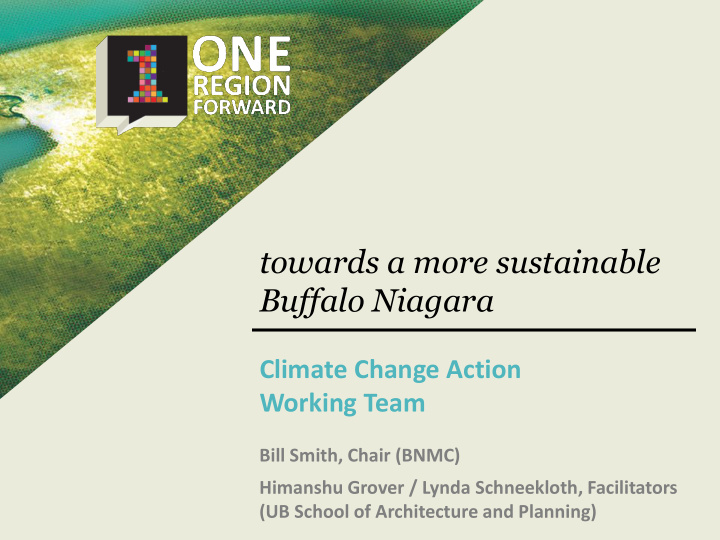



towards a more sustainable Buffalo Niagara Climate Change Action Working Team Bill Smith, Chair (BNMC) Himanshu Grover / Lynda Schneekloth, Facilitators (UB School of Architecture and Planning)
Agenda • Welcome, Introduction and Process Update • Presentation of Draft Climate Adaption Plan • Discussion and Synthesis of Plan in relation to goals and strategies of Climate working group • Strategy Development: Actions/Lead Agenda/Tmelines/etc • Summary and Next Steps
Working Team Process and Timeline
Climate change adaptation plan response plan
REPORT ORGANIZATION • • Introduction Recommended Adaptation Strategies – – Vision Statement Strategies for effective action – – What does this plan provide? Broad Adaptation Strategies – – Planning goals Targeted Adaptation Strategies – – Plan Organization Integration with other planning initiatives • • Reality of Climate Change Appendices – – Projected impacts in Upstate New York Methodology for community self assessment • Community Profile – Methodology for organization self- – Local authority assessment – Demographic analysis – Checklist for new development in a – Socio-economic composition changing climate – Greenhouse gas Emissions – List of resources that provide more details • Vulnerability Assessment on climatic changes – – Social vulnerability assessment List of available financial incentives – Physical Vulnerability Assessment – Specific Concerns – Infrastructure and general environment
GOALS 1. Provide appropriate guidance and information to ensure that local communities are better prepared in face of changing climatic trends in the region. 2. Identify important areas of concern across that will need to be addressed across different sectors to enhance community resilience. 3. Evolve a comprehensive methodology for climate change vulnerability assessment that can be implemented across the region.
GOALS 4. Outline a balanced approach to addressing climate change through a combination of – Conservation, Mitigation, Adaptation, and Awareness strategies. 5. Encourage strategies with tangible benefits across multiple sectors that will also contribute to local economic growth and wealth creation 6. Identify actions that will support continued sustainability of Great lakes and other natural resources in the region
Objectives 1. Assess existing risks and vulnerabilities from climate change 2. Promote Green House Gas (GHG) mitigation efforts and energy conservation initiatives 3. Promote attention to climate change issues within other planning initiatives and sectors, including the regional, and local land use plans. 4. Seek opportunities to inform the community and decision makers on potential climate change impacts
Objectives 1. Promote collaborations to raise awareness about climate change impacts 2. Seek opportunities to develop an environmentally sustainable economy 3. Maintain and add to the city‘s urban tree canopy and increase tree diversity within urbanized areas 4. Support protection of the Great Lakes
NOTABLE IMPACTS Expected Changes in Climate
IMPLICTAIONS FOR OUR REGION • Increased frequency, duration, and intensity of heat waves • Increased extreme weather conditions • Increased rain events – more stream flow, increase erosion and run-off, flood-risks • More stress on aging infrastructure • Lake levels • In-migration from the Coasts and the Mid- west
A combination of Technical and Working Group Reccomednations RESPONSE STRATEGIES
BROAD STRATEGIES • CONSERVATION – Plan, design, develop an manage our region for energy efficiency and conservation to reduce our carbon footprint • MITIGATION – Invest in renewable energy production, specifically from wind, solar, hydro-electric, and geothermal sources by developing progressive policies and funding mechanisms
BROAD STRATEGIES • ADAPTATION – Anticipate and prepare to adapt to the already inevitable impacts of climate change under way now • AWARENESS – Promote outreach and engagement efforts to educate people and decision makers about the implications of climate change for our region, and ways it can be addresses through mitigation, and adaptation
BROAD STRATEGIES • WEALTH CREATION – Use energy policy and climate change response strategies as economic impetus to create jobs and support local industries and businesses • GREAT LAKES CONSERVATION – Protect great lakes which is an integral part of western New York, and an enormous fresh water resources for the region and beyond
TARGETED RECCOMENDATIONS • Drainage and Flood Protection Infrastructure – Updating of Flood Maps – Use of 500yr floodplain boundaries in new development review – Stronger Flood management ordinances in all communities – Increase in the flood protection elevations – Improvement to storm water master plans – Incorporation of Green Infrastructure in Storm water management – Developing Independent Storm water Utility Districts (SUD)
TARGETED RECCOMENDATIONS • Drinking Water – Water supply assessment – Implement a water loss control program – Water demand management – Retrofitting plumbing systems
TARGETED RECCOMENDATIONS • Waste water – Target new development in existing sewer districts – Implement combined sewer overflow (CSO) abatement programs • Built Environment – Improved energy efficiency standards for buildings – Encourage passive design systems • Environmental quality and human health – Prepare public health plans for the region – Enhanced programs for controlling the disease causing vectors
SUGGESTED INDICATORS • Net-energy consumption per-capita • Green energy generation per-capita • Energy savings through energy efficiency projects • Transit trips per-capita • Vehicles miles travelled per-capita • Change in per-capita urban area • Alternative fuel stations • Length of total bike lanes • Developed land per-capita
TODAY’S TASK Review list of proposed strategies and identify potential actions, implementation time-frame, potential sources of funding , and prioritize.
Recommend
More recommend